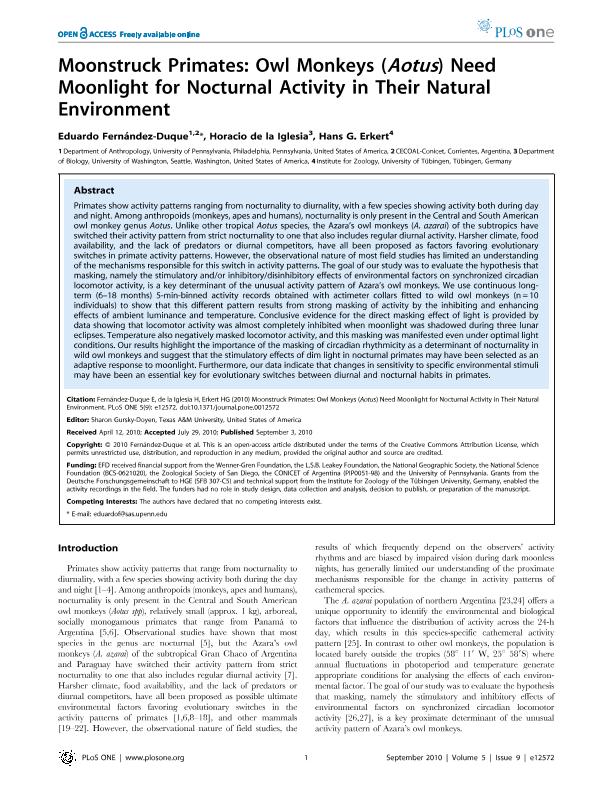Artículo
Moonstruck Primates: Owl Monkeys (Aotus) Need Moonlight for Nocturnal Activity in Their Natural Habitat
Fecha de publicación:
09/2010
Editorial:
Public Library of Science
Revista:
Plos One
ISSN:
1932-6203
Idioma:
Inglés
Tipo de recurso:
Artículo publicado
Clasificación temática:
Resumen
Primates show activity patterns ranging from nocturnality to diurnality, with a few species showing activity both during day and night. Among anthropoids (monkeys, apes and humans), nocturnality is only present in the Central and South American owl monkey genus Aotus. Unlike other tropical Aotus species, the Azara's owl monkeys (A. azarai) of the subtropics have switched their activity pattern from strict nocturnality to one that also includes regular diurnal activity. Harsher climate, food availability, and the lack of predators or diurnal competitors, have all been proposed as factors favoring evolutionary switches in primate activity patterns. However, the observational nature of most field studies has limited an understanding of the mechanisms responsible for this switch in activity patterns. The goal of our study was to evaluate the hypothesis that masking, namely the stimulatory and/or inhibitory/disinhibitory effects of environmental factors on synchronized circadian locomotor activity, is a key determinant of the unusual activity pattern of Azara's owl monkeys. We use continuous long-term (6-18 months) 5-min-binned activity records obtained with actimeter collars fitted to wild owl monkeys (n= 10 individuals) to show that this different pattern results from strong masking of activity by the inhibiting and enhancing effects of ambient luminance and temperature. Conclusive evidence for the direct masking effect of light is provided by data showing that locomotor activity was almost completely inhibited when moonlight was shadowed during three lunar eclipses. Temperature also negatively masked locomotor activity, and this masking was manifested even under optimal light conditions. Our results highlight the importance of the masking of circadian rhythmicity as a determinant of nocturnality in wild owl monkeys and suggest that the stimulatory effects of dim light in nocturnal primates may have been selected as an adaptive response to moonlight. Furthermore, our data indicate that changes in sensitivity to specific environmental stimuli may have been an essential key for evolutionary switches between diurnal and nocturnal habits in primates.
Archivos asociados
Licencia
Identificadores
Colecciones
Articulos(CECOAL)
Articulos de CENTRO DE ECOLOGIA APLICADA DEL LITORAL (I)
Articulos de CENTRO DE ECOLOGIA APLICADA DEL LITORAL (I)
Citación
Fernandez Duque, Eduardo; de la Iglesia, H.; Erkert, H. G.; Moonstruck Primates: Owl Monkeys (Aotus) Need Moonlight for Nocturnal Activity in Their Natural Habitat; Public Library of Science; Plos One; 5; 9; 9-2010; 1-6
Compartir
Altmétricas




